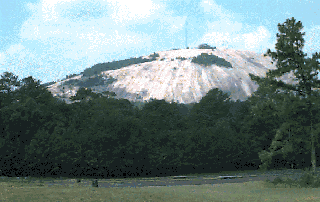 Stone Mountain is one of the largest granite formations
in the east. It is located in the
Piedmont region of Georgia, an area made up of hard igneous and metamorphic
rocks derived from the recrystallization of ancient sediment.
This sediment was re-exposed when the African and North American
continents collided 250 to 300 million years ago.
About 230 million years ago the Stone Mountain magma cooled approximately
6 miles below the surface of the land. Stone
Mountain is the result of an igneous intrusion and the light gray, fine- to
medium-grained granite that formed is made up of quartz, plagioclase,
microcline, muscovite, and biotite. Over
time, the granite was exposed as the land on top eroded.
The mountainís prominence over the current landscape is simply due to
the fact that the granite is far more resistant to erosion than the surrounding
landscape.
Stone Mountain is one of the largest granite formations
in the east. It is located in the
Piedmont region of Georgia, an area made up of hard igneous and metamorphic
rocks derived from the recrystallization of ancient sediment.
This sediment was re-exposed when the African and North American
continents collided 250 to 300 million years ago.
About 230 million years ago the Stone Mountain magma cooled approximately
6 miles below the surface of the land. Stone
Mountain is the result of an igneous intrusion and the light gray, fine- to
medium-grained granite that formed is made up of quartz, plagioclase,
microcline, muscovite, and biotite. Over
time, the granite was exposed as the land on top eroded.
The mountainís prominence over the current landscape is simply due to
the fact that the granite is far more resistant to erosion than the surrounding
landscape.
At
the East Quarry, you will find the freshest and least-weathered exposed rock.
This area was quarried until the late 1970s, so lichen and fungi, as in
many other areas of the mountain, have not covered the rock.
In this area, you can observe examples of flow structures, zoned granite
dikes, pegmatites, quartz veins, xenoliths, autoliths, and recent exfoliation.
The flow structures in the East Quarry vary from pronounced banding to
weak flow foliation. Where the flow banding is folded, it varies from gently
folded to lightly folded and ductily sheered.
In this area, it appears that the intrusion came from the east.
Zoned granite dikes are narrow, continuous lines that are lighter in
color than the surrounding granite. They
are intrusive structures that have symmetrical zoning and mye have a
light-colored, course-grained margin. There
are a variety of xenoliths present on Stone Mountain, including granite gneiss,
biotite-plagioclase gneiss, and muscovite-garnet-mica schists.
The xenoliths range from a few centimeters to one meter in length.
They are irregulary distributed, but are more common at the eastern and
western ends of Stone Mountain. Evidence
of recent exfoliation is common on Stone Mountain.
There are numerous locations where you will find the granite broken into
thin sheets as a result of a decrease in pressure on the top of the rock.
 On
the west side of the mountain, where the walk-up trail begins, you can find many
of the same geologic features. Quartz
veins are quite prevalent at the base of the trail and are so visible they are
frequently mistaken for painted lines on the granite. There is also a significant amount of vegetation on this side
of the mountain. Obviously the
growth of this vegetation took a great deal of time and was no small feat to
grow on solid granite. It takes
over 25 years for the granite to erode sufficiently for lichen to grow and after
the lichen mosses begin to grow followed by larger plants.
On Stone Mountain there are several species of plants that are found only
in this environment, including Yellow Confederate Daisies and Dimorpha.
These plants are sensitive to humans that unknowingly trample them and
the increasingly polluted Atlanta air.
On
the west side of the mountain, where the walk-up trail begins, you can find many
of the same geologic features. Quartz
veins are quite prevalent at the base of the trail and are so visible they are
frequently mistaken for painted lines on the granite. There is also a significant amount of vegetation on this side
of the mountain. Obviously the
growth of this vegetation took a great deal of time and was no small feat to
grow on solid granite. It takes
over 25 years for the granite to erode sufficiently for lichen to grow and after
the lichen mosses begin to grow followed by larger plants.
On Stone Mountain there are several species of plants that are found only
in this environment, including Yellow Confederate Daisies and Dimorpha.
These plants are sensitive to humans that unknowingly trample them and
the increasingly polluted Atlanta air.
Stone
Mountain is filled with scientific information for students to gather and
teachers to share. It is also a
wonderful location to conduct research on a unique environment and view a
variety of geological features.